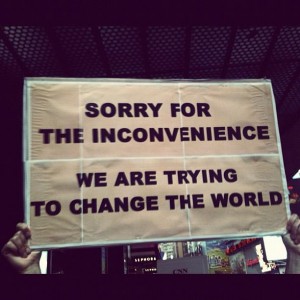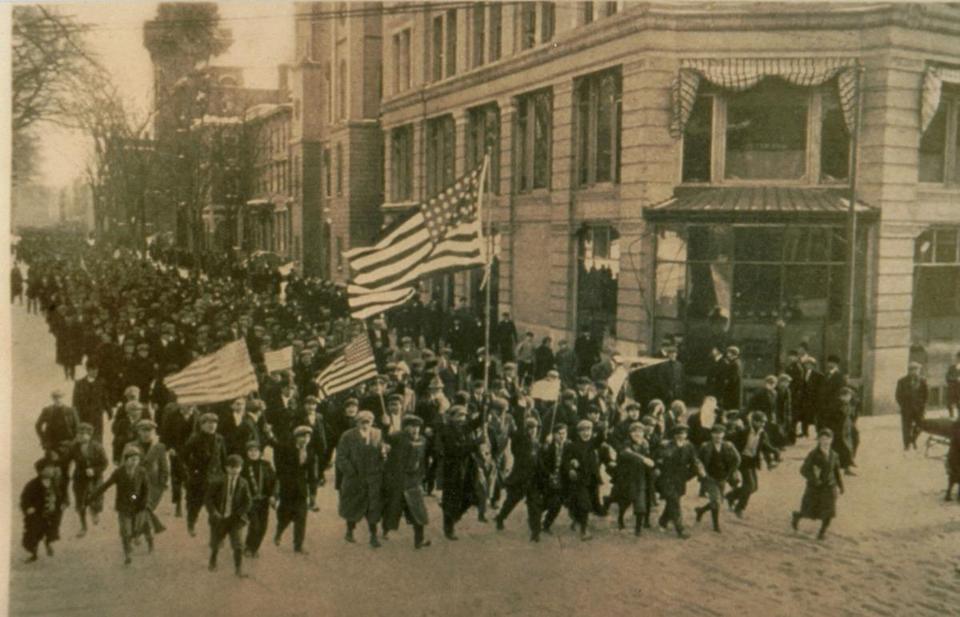Today, most of our mass media are controlled by one of six companies. Check out Frugal Dad’s infographic on the state of media consolidation in the U.S.
Source: Frugal Dad
From NOEBIE.net
Brian K. Noe · ·
Today, most of our mass media are controlled by one of six companies. Check out Frugal Dad’s infographic on the state of media consolidation in the U.S.
Source: Frugal Dad
Brian K. Noe · ·
With camps gone, Occupiers prepare for new fights. [chicagotribune.com] – In interviews with Occupy groups in more than a dozen states – on both coasts and across the Midwest – activists described training for nonviolent confrontation, plans for spring rallies at state capitols and preparations for a major presence at the G-8 and NATO summits to be held in Chicago in May.
Brian K. Noe · ·
Face Masks, Snipers and Aerial Surveillance: Chicago’s Newest Anti-Protest Measures Revealed. [Truthout] – Each time a new measure that the city of Chicago is preparing for the coming NATO and G8 summits is unveiled, the tension in the city ratchets up a notch. The latest news comes in the form of reports that Chicago has purchased face shields, and may be considering the implementation of airborne surveillance technology.
Brian K. Noe · ·
Student loans could be next ‘debt bomb’. [UPI.com] – More than four of five U.S. bankruptcy attorneys say the number of potential clients with student loan debt has increased in the past three to four years, with some saying student loan client cases have increased 25 to 50 percent during the period. “Take it from those of us on the front line of economic distress in America: This could very well be the next debt bomb for the U.S. economy,” William E. Brewer Jr., the president of The National Association of Consumer Bankruptcy Attorneys, said in a news release.
Brian K. Noe · ·
It is bewildering how many really smart, well-formed, progressive thinkers seem to have not yet achieved a critical shift in perception concerning the worldwide struggle for freedom and democracy.
Naomi Wolf recently wrote in The Guardian that Occupy needs to avoid getting “bogged down in consensus decision-making” and instead should focus on “media exposure, a clear message, smart soundbites, clearly stated demands, and, most importantly, tasked, empowered negotiators working on the inside in concert with mass disrupters applying pressure from without.” She cites some excellent examples of effective political advocacy from the past, including the work of Act Up in gaining fast-track approval for AIDS drugs that have since saved millions of lives.
This sort of “get to the point” criticism of the Occupy Movement has been raised from many quarters nearly ad nauseam since the very start – and it completely misses the point. Consensus decision-making is, in this movement, not a means to another end. It’s not about which method is most effective in building the movement or in achieving political goals. It is the goal.
Our current economic and governmental systems are pushing up against the natural physical limits of sustainability. They are, without a single solitary doubt, coming to an end – and quite soon, I think. The question is not whether the old order will fall, the question is what sort of new order will take its place.
As I see it, there are only two alternatives: slavery or community. Either we will drift increasingly toward a system that is dominated by ever more repressive governments at the service of multi-national corporations (that will continue to plunder and exploit until nothing is left), or we will find ways to create local, self-governing, non-coercive associations where people willingly work together to ensure that everyone has the basic necessities of life and the opportunity to develop their true human potential.
The Occupy Movement is creating and demonstrating that model. Making decisions by consensus is the entire point. If that process is abandoned for the sake of “efficiency” – or even “effectiveness” – the battle will have already been lost.
It is a waste of precious time and energy to tinker around at the edges in a quest for political influence over systems that are already crumbling. It is time to create the new society within the shell of the old.
The “leaderless movement” is leading the way.

Brian K. Noe · ·
Thanks to Uncle Rush for his dedication to the cause. Let freedom ring!
Visit OccupyDream.org for more.
Brian K. Noe · ·
Brian K. Noe · ·
Today marks the 100th anniversary of the Bread and Roses Strike in Lawrence, Massachusetts – a formative moment in American Labor history, and an inspiration to workers and lovers of liberty to this day.
Solidarity!

Bread and Roses a Hundred Years On. [Industrial Worker] – Though 100 years have passed, the Lawrence strike resonates as one of the most important in the history of the United States. Like many labor conflicts of the 19th and early 20th centuries, the strike was marked by obscene disparities in wealth and power, open collusion between the state and business owners, large scale violence against unarmed strikers, and great ingenuity and solidarity on the part of workers. In important ways, though, the strike was also unique. It was the first large-scale industrial strike, the overwhelming majority of the strikers were immigrants, most were women and children, and the strike was guided in large part by the revolutionary strategy and vision of the Industrial Workers of the World (IWW).
100 years later, Bread and Roses strike still resonates. [The Boston Globe] – The Bread and Roses Strike, not only called attention to horrific conditions in the mills, but also to the concentration of wealth and power in the United States,an issue that 100 years later would spur protesters to Occupy Wall Street, Boston, and other cities across the country.
100 Years After Lawrence Strike, the Cry for ‘Bread & Roses’ Still Resonates. [In These Times] – The strike that started on January 12, 1912, created political tremors far beyond the Merrimack Valley. The shutdown of mills in Lawrence forced a national debate about factory conditions, child labor, the exploitation of immigrants and the free exercise of First Amendment rights during labor disputes.
Bread and Roses: The 1912 Lawrence textile Strike. [Joyce Kornbluh, The Lucy Parsons Project] – Early in January 1912 I.W.W. activities focused on a dramatic ten-week strike of 25,000 textile workers in Lawrence, Massachusetts. It became the most widely publicized I.W.W. conflict, acquainting the nation with the plight of the unskilled, foreign-born worker as well as with the organization’s philosophy of radical unionism. “Lawrence was not an ordinary strike,” wrote Brissenden in 1919, “It was a social revolution in parvo.”
100 Year Anniversary of Bread and Roses Strike. [Uprising Radio] – Given today’s economic climate and the rising opposition to wealth inequality in the US, the history of the Bread and Roses strike of 1912 is particularly relevant.
Remembering the Fight and Spirit of “Bread and Roses.” [Common Dreams] – The strike lasted for two months. The workers marched daily, singing union anthems, and later listening to organizers. They faced clubs, bayonets, and frequent arrests. Many were hauled off to jail, children in tow. One, Annie LoPizzo, was shot and killed by the police.
Documentary Shows Strike “From The Workers’ Point of View.” [Merrimack Valley Eagle Tribune] – Making movies and local history are close to Tom Gradzewicz’s heart. He has combined his two passions to create “The Strike Heard ‘Round the World: Bread & Roses 1912,” which will be broadcast on community access television stations throughout Greater Lawrence.
A Century of Writing on the IWW. [IWW.ORG] – An annotated bibliography prepared for the IWW Centennial in 2005.
Bread & Roses Centennial Committee Website
Bread and Roses/Makhnes Geyen. [Boston Workmen’s Circle A Besere Velt (A Better World) Yiddish Chorus] – A stirring performance at the Rosenberg Fund for Children’s “Celebrate the Children of Resistance” event in Boston, June 19, 2007. The song is a ballad from the 1912 Lawrence, MA textile strike, woven together with an anthem dedicated to the fighters in the Spanish Civil War. “The masses are marching in the struggle for victory.”
Brian K. Noe · ·
Fed’s Lofty Profit Becomes Treasury’s Gain. [WSJ.com] – The Federal Reserve turned $76.9 billion of its profits over to the U.S. Treasury last year, close to the record amount transferred to government coffers in 2010 amid gains generated in its expanding portfolio of securities.
Brian K. Noe · ·
The excellent conversation with Chris Hedges that aired live on Book TV New Year’s Day is now available to view online. This broadcast is three hours long, but it is highly recommended to anyone who cares about liberty (and life) on this planet.
Follow the link below for more.
In Depth with Author and Journalist Chris Hedges. [C-SPAN] – On Book TV’s In Depth, author and journalist, Chris Hedges. The Pulitzer Prize winning foreign correspondent spends three hours taking viewers’ calls, emails and tweets on topics such as terrorism, religion and politics.